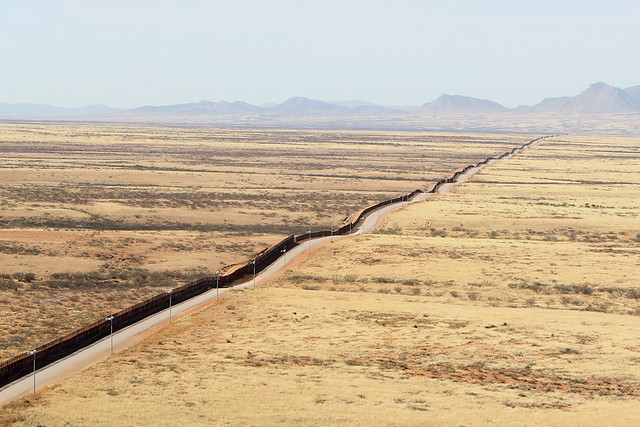
President Donald Trump’s latest ploy to garner funding for a border wall between the US and Mexico was to try to impose a minimum 5% tariff on Mexican imports from 10 June. The move was intended to be used in Trump’s second-term bid to demonstrate that Mexico was paying for the wall—as Trump pledged it would during the 2016 presidential campaign.
However, Trump has now backed off on imposing tariffs—at least for 45 days—due to strident domestic criticism and because Mexico has agreed to try to stop the flow of Central American asylum seekers reaching the US southern border through Mexico.
Throughout his campaign, Trump boasted to supporters: ‘I would build a great wall, and nobody builds walls better than me, believe me, and I’ll build them very inexpensively. I will build a great, great wall on our southern border. And I will have Mexico pay for that wall.’
Of course, Mexico never had any intention of paying for the wall. (Trump, in his first phone call with Mexico’s then-president, Enrique Peña Nieto, actually implored Nieto to stop saying publicly that Mexico wouldn’t pay for the wall.)
Since gaining office, Trump has moved away from his concept of a great border wall (of the kind built by the Israelis) to a southern border fence of ‘artistically designed steel slats’.
Trump has also ‘clarified’ that his wall will only need to cover half the 3,200-kilometre coast-to-coast distance because mountains and rivers provide adequate coverage in some areas. It would also be an extension (and partial replacement) of the existing barrier that runs along part of the Mexico–US border.
Even so, a new barrier, at least 1,000 kilometres long, would be an immense and costly undertaking.
On 25 January 2017, Trump signed an executive order that formally directed the US government to begin constructing the border wall using existing federal funding. Construction didn’t begin due to the anticipated huge expense and concerns about who was going to pay for it.
Because of Trump’s declared intention to veto any spending bill that didn’t include funding for his wall, the US federal government was partially shut down for a record 35 days from 22 December 2018 to 25 January 2019.
Congress has so far approved US$1.7 billion in funding for less than 200 kilometres of new and replacement barrier.
Trump claimed in a national address on 8 January that a new wall was necessary to stop a ‘growing humanitarian and security crisis at our southern border’, involving ‘thousands of illegal immigrants’.
On 15 February, Trump signed a declaration of national emergency, saying that the situation at the southern border was ‘a crisis’ requiring money allocated for other sources to be used instead to build the wall. Congress passed a joint resolution to overturn the emergency order. In retaliation, Trump vetoed the resolution.
How valid is Trump’s claim that a border barrier is needed to enhance American security?
In 2018, the number of asylum seekers at the southern border was just under 400,000. This year, the numbers are trending up—presumably due to local perceptions of a declining security situation in Central America and concerns that the US might enforce tougher asylum restrictions.
Although Trump blames a porous southern border for the large number of ‘illegals’ in the US, the reality is that most of these people are legal entrants who overstayed their visas—more than 700,000 of them in 2017. Canadians were the largest group of overstayers.
Narcotics entering the US from Mexico mostly come in through official points of entry concealed in vehicles.
As for the terrorism threat, perpetrators of terrorist attacks in America have entered legally by aircraft or ship, or by road across the Canadian border. None have come in from Mexico.
Estimates of the cost of the new border barrier demanded by Trump range from US$12 billion to US$70 billion. US Customs and Border Protection says on average it costs US$6.5 million per mile (or about US$4 million per kilometre) to construct a new border wall or replace existing fencing.
Even then, unless the barrier was monitored 24/7, people would get over it, through it, or under it.
A further complicating factor with building a new barrier is that two-thirds of the US–Mexico border runs along privately owned or state-owned land, and the US government would need to acquire land through ‘eminent domain’ purchase, or seizure, to build a border fence. That process could take years of complex litigation—as was the case with the existing barrier.
Trump will, as usual, manipulate the facts to suit his case, but it’s clear that a border barrier of the kind he originally promised his supporters is never going to happen.

